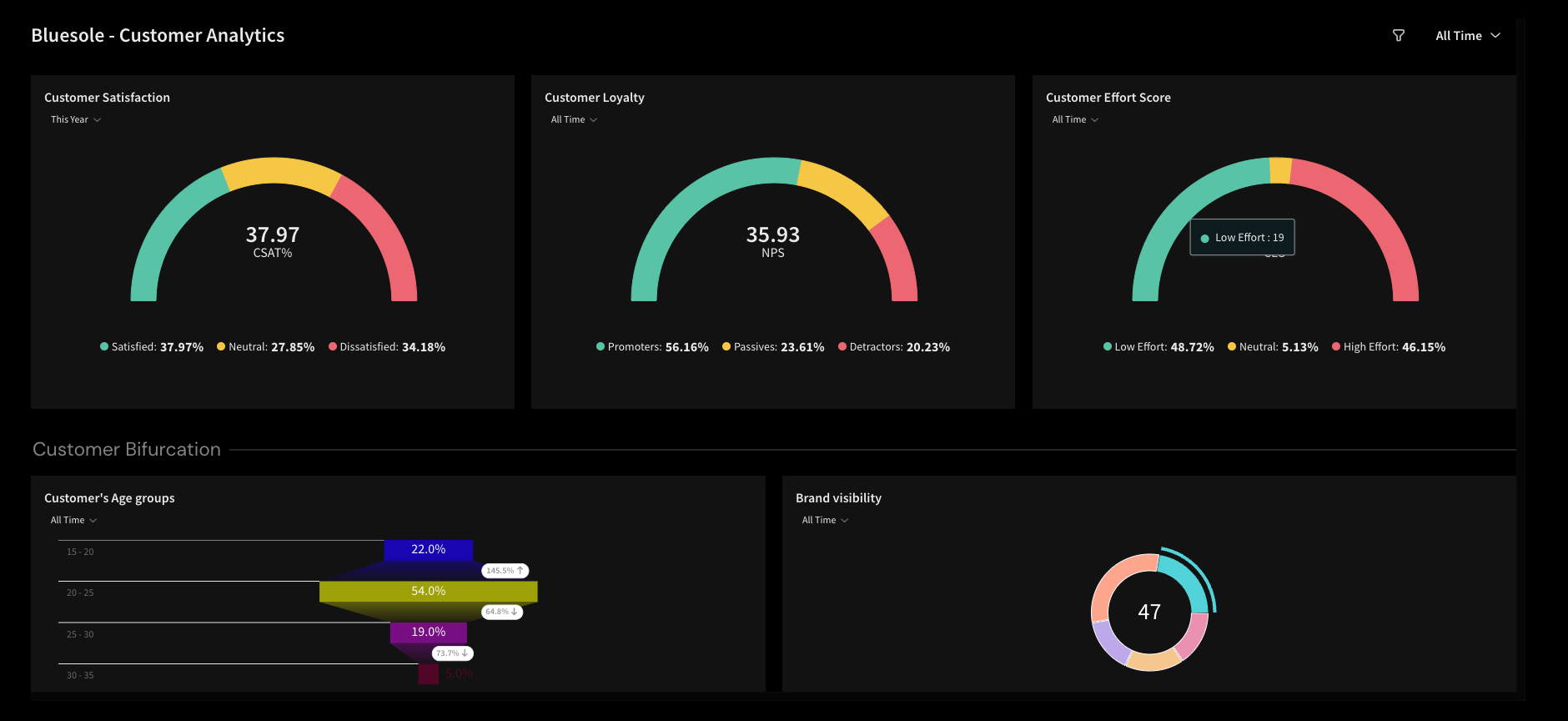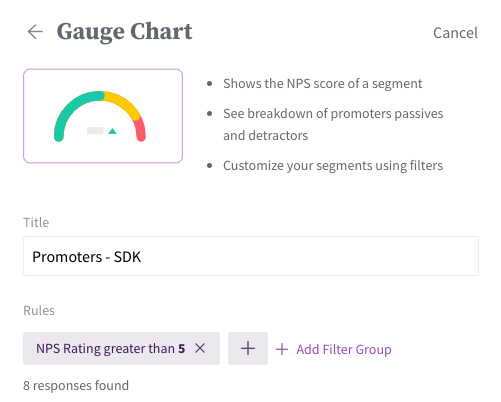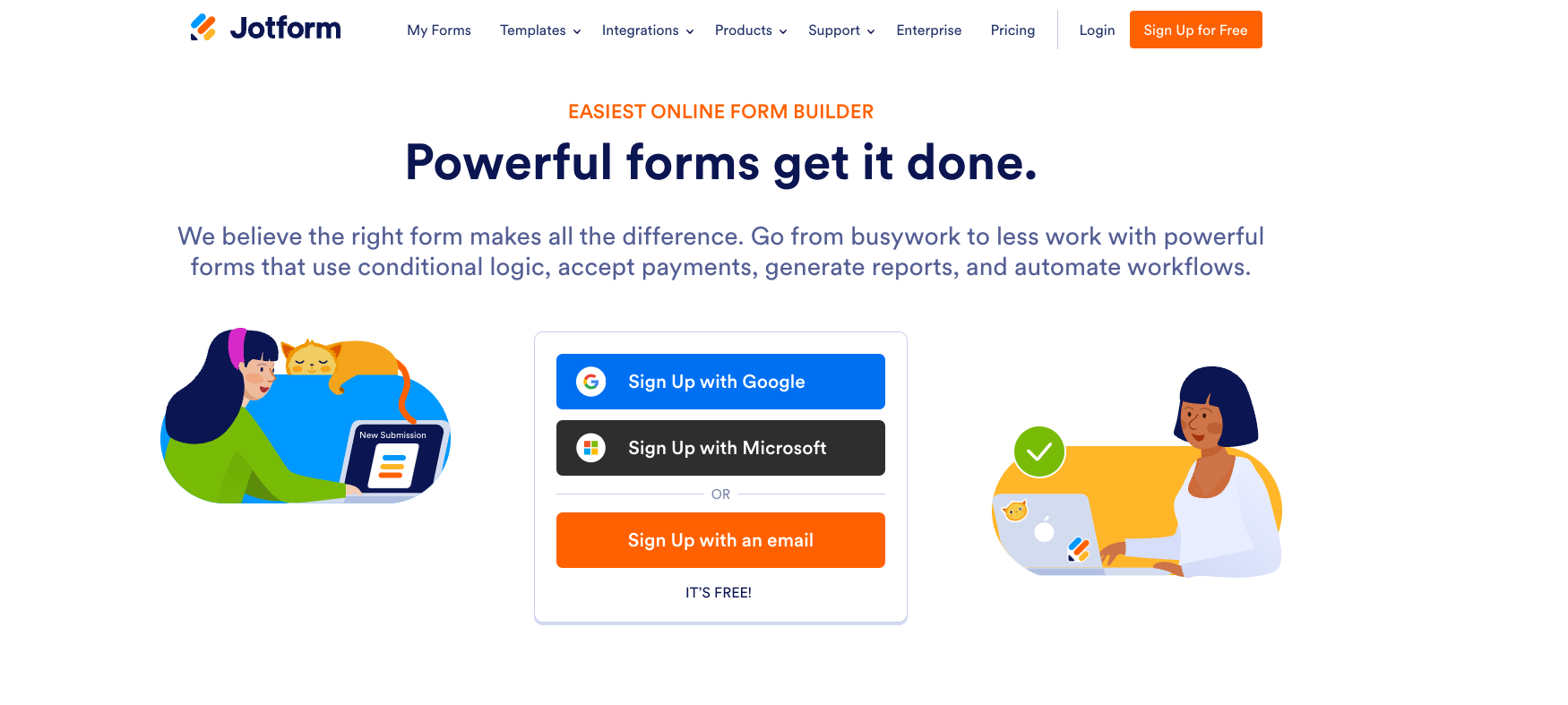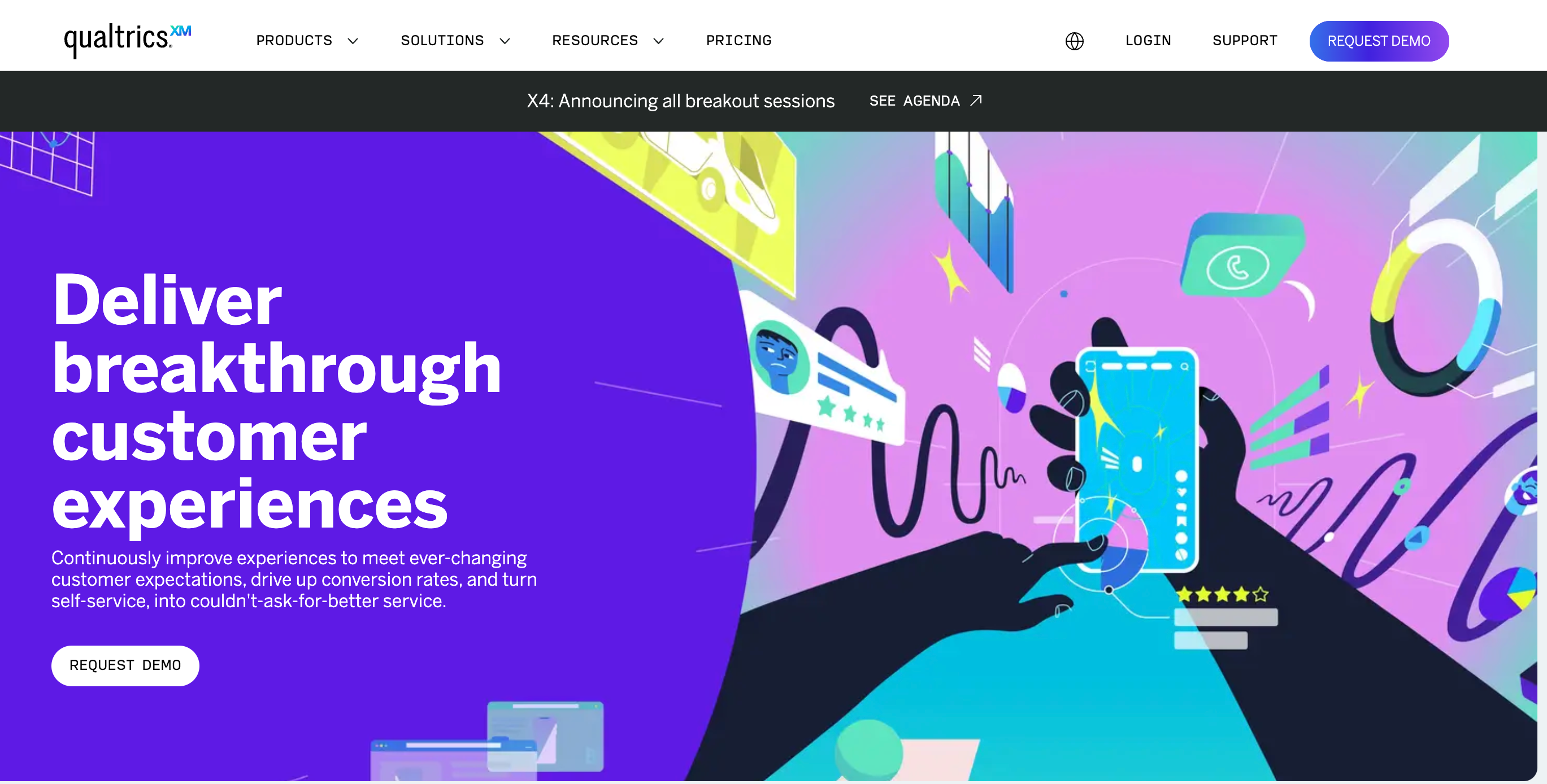Best Of
9 Best Customer Satisfaction Survey Tools For Your Business
Article written by Kate Williams
Content Marketer at SurveySparrow
17 min read
10 November 2024

Customer satisfaction is always crucial for repeat business. Duh, right? But the question is – how best to measure your customers’ satisfaction level?
Enter customer satisfaction survey tools (or CSAT survey tools).
These tools offer a range of survey options to gauge your customer’s satisfaction and loyalty level over time. With this blog, we intend to help you identify the options available for CSAT tools and aid you in choosing the right one for your business.
Top 9 Customer Satisfaction Survey Tools
There are a lot of survey tools available online that can help you with measuring customer satisfaction. However, the ones we list here are the top and best software tools in the industry. Here’s an overview of the tools –
Let’s discuss each CSAT tool in detail.
1. SurveySparrow

Being the best online survey tool in the market, SurveySparrow could be the right tool for measuring customer satisfaction. It’s surveys are conversational and chat-like, making it engaging and improving the response rate.
Here’s how SurveySparrow positions itself as one of the best customer satisfaction survey tools.
Customer Satisfaction Surveys [CSAT]
It’s obvious what this survey is for, right? How SurveySparrow differs from others is how you can make use of the data you get. Any tool can collect feedback and give you a CSAT score.
With proper feedback analysis, you can find hidden opportunities for improving your service/product. As a result, you make improvements that actually improve your customer satisfaction.

Here’s a free customer satisfaction survey template you can try out.
Customer Satisfaction Survey Template
Use This TemplateNet Promoter Score [NPS]
Yes, NPS is actually for gauging customer loyalty. But it can also help determine satisfaction. The more the promoters you have, the more satisfied your customers are.
SurveySparrow offers NPS tools to not just understand the NPS score but also the NPS results. It offers widgets to dissect the NPS data to uncover crucial insights for improving customer satisfaction.

Follow the link if you want to learn more about NPS.
Customer Effort Score [CES]
The customer effort score is used to measure the ease of customer interaction and resolution of their needs. If the interactions are seamless and the issues are quickly resolved, then automatically, the satisfaction improves. And you guessed it right, SurveySparrow helps you do an in-depth analysis of feedback data.

Apart from these, SurveySparrow helps you measure satisfaction through –
- VoC tools to help you gather, analyze, and respond to customer feedback across different channels.
- Online reputation management to track, monitor, and analyze reviews and feedback on public platforms.
- Measure the satisfaction level of your customers at each crucial touchpoint.
- Transactional surveys to gauge customer experience after a specific transaction.
- Exit surveys to identify the reason for customer churn. This way, you can find areas for improvement and enhance satisfaction.
- Distribute the surveys across 10+ channels.

Pros
- 1000+ survey templates
- Multilingual surveys
- White labelling
- Great customer support
- Advanced text and sentiment analysis
- AI surveys
Cons
- Only 20 survey question types
Pricing
A free forever plan and free trial is available for you to test the efficiency of the tool. The plans include ht following. Individual plans –
- Basic – starts at $19 per month
- Starter – starts at $39 per month
Team plans –
- Business – starts at $79 per month
- Enterprise – starts at $249 per month
There is also an option for you to get a customized quote based on your requirements. You can learn more about them by visiting their pricing page.
Customer Rating & Review
- G2 Rating: 4.4 (1900+ reviews)
- Capterra Rating: 4.4 (100+ reviews)
Customer Review
“SurveySparrow as a platform for Customer Initial Evaluation tool. The product has a very humanlike vibe, making it much more enjoyable than standard survey solutions (like Google or Microsoft Forms) as per UX. There are many ways to customize the UI.” – SurveySparrow G2 Profile.

Explore Deeper Customer Insights with SurveySparrow
A personalized walkthrough by our experts. No strings attached!
2. Typeform

Typeform is yet another tool you can try to measure customer satisfaction. It also offers NPS, CSAT, and CES surveys, although it lacks VoC programs. Take a look at its key features.
Features of Typeform
- Embedded surveys to collect customer feedback from websites.
- 800+ in-built survey templates.
- Customize the surveys to align them with your brand elements and requirements.
- Skip and conditional logic to make the surveys dynamic.
- The forms and surveys are mobile-optimized.
Pros
- Easy-to-use interface
- Presents only one question at a time
- Integrations with CRM
Cons
- Expensive for the features offered
- Poor customer support
- Fewer user analytics abilities
Pricing
Typeform also offers a free version and trial. The pricing is like $25 per month for 100 responses (1 user) when billed annually. This kind of pricing is one of the reasons why users look for better alternatives to Typeform.
Customer Rating & Review
- G2 Rating: 4.5 (700+ reviews)
- Capterra Rating: 4.7 (800+ reviews)
Customer Review
“Typeform allows for the fast creation of simple surveys with branching logic, which is helpful. It’s also easily embedded into websites, which is a good feature. Only the pricing, because small businesses cannot afford their paid plans.” – Typeform G2 Profile.
3. Jotform

Jotform is an online form builder and survey software that can help you with satisfaction measurement. It has a user-friendly interface and over 10,000 templates to help users collect customer feedback effectively. Like the other two tools we discussed, Jotform also offers NPS, CSAT, and CES surveys. However, it lacks online reputation management and VoC programs.
Features of Jotform
- It supports a wide range of form fields, including sliders, CAPTCHA, and date pickers.
- The survey designs are mobile-friendly and responsive.
- Simple drag-and-drop options make the form-creation process smoother and quicker.
- Offline surveys to collect feedback where there is no internet connectivity.
- Robust integration with third-party tools.
Pros
- Good customization options
- Very easy to use
- Mobile forms are easy and accessible
Cons
- Not enough storage space
- Expensive than other CSAT survey tools
Pricing
A free version is available. The starting price of their paid plans begins from $34 per user per month when billed annually.
Customer Rating & Review
- G2 Rating: 4.7 (3000+ reviews)
- Capterra Rating: 4.6 (1900+ reviews)
Customer Review
“One of the things I really like and appreciate from Jotform is how user-friendly it is. It’s easy to navigate interface, the diversity of customization options, and how easy it is to integrate with other apps.” – Jotform G2 Profile.
4. SurveySensum

SurveySensum is yet another online survey tool that’s also one of the best customer satisfaction survey tools. The tool prides itself in its ability to help its customers make sense of the customer data and make informed decisions. The customer satisfaction and NPS surveys provided by the tool allow you to measure and improve overall customer satisfaction.
Features of SurveySensum
- Conversational analytics to get deeper customer insights, including audio reviews.
- Share customer satisfaction surveys through WhatsApp.
- Trigger options to notify users whenever a customer leaves feedback.
Pros
- Advanced analytics
- Closed feedback loop
- Good customer support
Cons
- Lacks in-built survey templates
- Slight learning curve
Pricing
The free version of the tool provides 25 responses and 500 emails per month. The details of their pricing are available upon request. No free trial is available.
Customer Rating & Review
- G2 Rating: 4.6 (20+ reviews)
- Capterra Rating: 5 (1 review)
Customer Review
“The product is easy to use and helps in analysing the results in a better way and provides insights that we cannot ignore.” – SurveySensum G2 Profile.
5. Survicate

By offering NPS, CES, and CSAT surveys, Survicate also stands out as a worthy customer satisfaction survey tool. The tool is actually a customer feedback software that helps businesses gather customer insights. It’s known for its ease of use and simpler user interface. Through target surveys, it can engage with customers at various touchpoints, enhancing satisfaction.
Features of Survicate
- Distribute surveys to specific customer segments with targeted surveys.
- In-app surveys can gather valuable feedback about your mobile app.
- Product surveys are dedicated surveys to collect user feedback to improve your product.
Pros
- Good customer support
- Easy to set up Intuitive
Cons
- Can’t work complex survey questions
- Very limited maximum responses per month
Pricing
The free forever plan allows you to gather 25 responses per month. Their paid plans start at $99 per month for 250 responses per month.
Customer Rating & Review
- G2 Rating: 4.6 (150+ reviews)
- Capterra Rating: 4.5 (20+ reviews)
Customer Review
“It allows product, marketing and CS teams within our company to set up and run their own surveys with little to no assistance from the market research team. My only concern is the lack of more advanced functionalities & advanced analytics.” – Survicate G2 Profile.
6. Qualtrics

Qualtrics is a comprehensive experience management platform known for its advanced customer data analytics. As part of their experience management, they provide online surveys. These surveys can help measure customer satisfaction. It combines research, feedback, and operational data to provide a complete view of the customer journey.
The following are some key features that make it a top customer satisfaction survey tool.
Features of Qualtrics
- Monitor customer interactions across channels through multichannel feedback collection.
- AI-powered analytics to analyze customer data and predict customer behavior.
- Understand the points of friction in the customer journey through planned surveys and improve satisfaction.
- The surveys are highly customizable and support a vast array of survey question types.
Pros
- Advanced features in surveys
- Variety of question types
- Compatible with any device
Cons
- Very expensive
- Steeper learning curve
- Ability to manipulate data within the tool itself [to be done each one manually]
Pricing
You can get a free plan for using their online survey tool, though the features are very limited. Their start price is a bit expensive, with $120 per month for just one user. Follow the link if you are looking for cost-effective tools [alternative] to Qualtrics.
Customer Rating & Review
- G2 Rating: 4.4 (500+ reviews)
- Capterra Rating: 4.6 (200+ reviews)
Customer Review
“Qualtrics has many advanced features that, if used properly, can lead to an extremely well-crafted survey. For example, you can utilize display logic to skip certain questions based on how previous questions were answered. My only issue with Qualtrics is that it is a little difficult when it comes to collaboration.” – Qualtrics XM G2 Profile.
7. AskNicely

AskNicely is a customer feedback software that helps you measure every customer experience. It uses an NPS feedback system to gather feedback in real-time. The collected feedback can be analyzed to improve customer satisfaction. Therefore, the tool can be considered an ideal tool for measuring customer satisfaction.
Features of AskNicely
- The surveys are customizable and can be shared through web, mobile, and email.
- The customer data can be connected with CRMs and other intelligence tools for deeper analysis.
- Effectively close the loop by automating the workflow.
- Segment users based on criteria such as demographics, transaction types, etc.
Pros
- Easy to use and intuitive
- Great workflow automation
- Good technical support
Cons
- Expensive than other CSAT survey tools
- Poor built-in reports
Pricing
You can book a free demo to understand how the tool works. The details of their pricing can be found upon contact.
Now, you might be wondering how we came to the conclusion that it is expensive. Well, we analyzed the customer reviews in G2 and Trustradius and found several comments regarding them.
Customer Rating & Review
- G2 Rating: 4.7 (900+ reviews)
- Capterra Rating: 4.6 (100+ reviews)
Customer Review
“Using AskNicely for our semi-annual NPS surveys and daily 5-star transactional surveys helps us keep our finger on the pulse of what we are doing right for our customers and importantly, what we need to do better.” – AskNicely G2 Profile.
8. QuestionPro

QuestionPro is a complete online survey software that also supports customer satisfaction surveys. It provides deeper insight into customer behavior, helping you improve overall customer satisfaction.
But what makes it a good customer satisfaction survey tool? Let’s have a look.
Features of QuestionPro
- Multilingual surveys to collect feedback from anywhere around the globe.
- Customizable survey designs with proper welcome and thank you pages.
- Survey panel integration will allow you to connect with your target audiences.
- Real-time data collection and analysis for immediate customer insights.
Pros
- Good analytics features
- Mobile optimized surveys
- Handles anonymous surveys well
- A vast range of survey question types
Cons
- Outdated interface
- Conditional logic isn’t flexible
Pricing
There’s a free version of its survey software with 200 responses per survey. The paid plans start at $83 per user per month.
Customer Rating & Review
- G2 Rating: 4.5 (900+ reviews)
- Capterra Rating: 4.8 (400+ reviews)
Customer Review
“It’s a useful, well polished (and mature) product. It’s very customizable for surveys – each question can be customized to present the user with the most concise options.” – QuestionPro G2 Profile.
9. Zoho Forms

Part of the Zoho suite, Zoho Forms is a versatile online survey and form builder app. It’s designed to collect and manage data across various contexts, including satisfaction surveys. The tool is known for its cost-effectiveness and ease of use.
Features of Zoho Forms
- Embed secure forms to interact and engage with your customers on the website.
- Share the survey link across different platforms to collect feedback.
- Trigger email and SMS notifications will notify you whenever a customer leaves feedback.
- Export or connect customer data with other apps for detailed analysis
Pros
- Great for Zoho suite users
- Very easy to use
- Cost-effective
Cons
- Poor integrations with non-Zoho products
- Lacks advanced analytics compared to other CSAT survey tools
- The surveys are not optimized for mobile
Pricing
You can get a free version with limited features. The pricing for Zoho Forms is very cheap, starting at a meager $8 per month.
Customer Rating & Review
- G2 Rating: 4.4 (150+ reviews)
- Capterra Rating: 4.5 (100+ reviews)
Customer Review
“When you talk of simplicity, then Zoho Forms is such kind of simplicity that we needed for form building. It has excellent form building and editing features which includes use of drag and drop technology to make it so easy to build forms.” – Zoho Forms G2 Profile.
Why are Customer Satisfaction Survey Tools Essential for Businesses?
As discussed in the introduction, it’s not a secret that businesses need to keep their customers satisfied for repeat business. Therefore, customer satisfaction survey tools are crucial. There are a lot of compelling reasons why to use CSAT tools.
The following are five among them.
Gathering Valuable Feedback
You can’t improve customer satisfaction without knowing your customer preferences. So, it’s key to collect customer feedback. This can be done through focused surveys or forms.
Pro Tip: Use survey tools like SurveySparrow. Its conversational interface enacts a higher response rate – meaning more feedback.
Spot Areas to Improve
Customer feedback is essentially a gold mine for businesses. This is the case, provided you are using robust survey tools like SurveySparrow. Why? Because these tools can perform in-depth data analysis (sentiment and text) to uncover hidden patterns and emotions.
As a result, it unveils areas where customers are dropping off or experiencing friction. Businesses can subsequently improve these areas and enhance customer experience.
Enhance Customer Retention
Satisfied customers tend to stay with a brand or a business. So, by helping improve satisfaction, CSAT survey tools ensure a better retention rate. Also, satisfied customers tend to be more vocal and may even suggest your brand to others. This leads to increased customer acquisition as well.
Improve Product/Service
As we discussed, customer feedback can be a goldmine for businesses. The feedback may offer actionable insights into how products or services can be enhanced.
Furthermore, these customer feedback allows businesses to better understand customer needs and expectations. As a result, businesses can tailor their product or service to meet them – improving satisfaction.
Build Brand Reputation
Once you have worked on the customer feedback, make sure to let the customers know of the same. By showing that you have valued their feedback and worked on it, you are showing your commitment to them.
This act can make customers feel valued and build a positive brand reputation among them. Moreover, customers sharing their experiences with others can further enhance your brand’s image in public.
These are only five of the many advantages of using customer satisfaction survey tools. Though this is the case, like in the case of all other tools, choosing the right tool matters here as well.
Decide on what your end goal is and look for the tool to help you meet them. Exploring the free version and trials offered by these tools might be a start. This will clearly give you an idea of how efficient each tool is.
Start with SurveySparrow and work your way down the list of satisfaction survey tools we discussed. Scrutinize each tool and choose the one that fits your business.

FAQs on CSAT Survey Tools
1. What is a CSAT Survey?
Surveys that helps you measure the satisfaction level (or score) of your customers is what CSAT surveys means. An example of a CSAT survey questions is as follows –
“On a scale of 1-5, how satisfied are you with the product’s performance?”
2. What are Customer Satisfaction Survey Tools?
Customer satisfaction survey tools are software that helps you collect and analyze feedback on customer experience. These tools provide engaging surveys to collect valuable feedback from customers. This collected feedback can be used to improve the overall customer satisfaction.
3. What Are the 4 Types of Customer Satisfaction Surveys?
The four types of customer satisfaction surveys are as follows –
- Net Promoter Score (NPS)
- Customer Satisfaction Surveys (CSAT)
- Customer Effort Score Surveys (CES)
- Post-transaction Surveys
Start 14 Days free trial

Kate Williams
Related Articles

Startup Journey
The One Where We Introduce Conversational Surveys
4 MINUTES
7 June 2018
![Create Engaging Image Surveys: Complete Guide with Examples [2025] what are image surveys](/_next/image/?url=https%3A%2F%2Fstatic.surveysparrow.com%2Fsite%2Fstrapi-content%2Fuploads%2F2024%2F11%2Fmedium_what_are_image_surveys_97d5c77a0e.png&w=3840&q=75)
Survey Tips
Create Engaging Image Surveys: Complete Guide with Examples [2025]
8 MINUTES
7 November 2024

Best Of
No-code: Why is it gaining traction?
6 MINUTES
1 July 2020

Knowledge
Is Google Forms HIPAA Compliant: Safeguard Patient Data
8 MINUTES
12 March 2024
